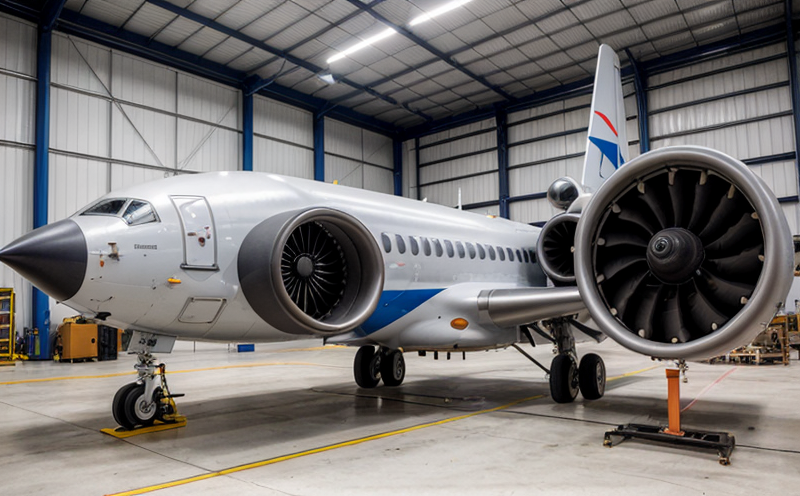Helicopter Blade Vortex Interaction Noise Testing
The helicopter blade vortex interaction noise testing is a critical service in aerospace and defense acoustics. This test evaluates the noise generated by the interaction between a helicopter's main rotor blades as they pass through vortices shed from their own trailing edges during flight. The primary focus of this testing is to quantify the noise produced, which can significantly impact the operational environment and crew comfort.
The process involves several key steps, starting with detailed analysis of the blade geometry and aerodynamic characteristics. This information is used to simulate realistic flight conditions in a controlled laboratory setting. Specimens are typically full-scale or scaled models that replicate real-world helicopter blades. The testing setup includes advanced acoustic measurement equipment capable of capturing sound pressure levels over a wide frequency range.
The testing procedure involves rotating the blade(s) at various speeds and angles, simulating different flight conditions such as takeoff, cruise, and landing. This allows for the accurate assessment of noise generated under these specific scenarios. Real-world usage notes are essential here; helicopters often encounter varying wind speeds and angles during their operations, which can influence the level of vortex interaction noise.
For compliance with international standards, this testing aligns closely with ISO 18423:2007 for helicopter blade design and certification. This standard provides a framework that ensures the accuracy and reliability of test results. The testing apparatus includes high-fidelity microphones positioned around the blade to capture sound waves accurately. Signal processing techniques are then used to analyze these recordings, providing detailed insights into the noise characteristics.
The acceptance criteria for this test are stringent, ensuring that any helicopter blade design meets safety and operational requirements. Compliance with these standards is crucial for manufacturers as it affects not only their product quality but also their ability to meet regulatory requirements. The results of this testing play a vital role in optimizing helicopter performance, enhancing crew comfort, and reducing the environmental impact associated with noise pollution.
| Test Parameter | Description |
|---|---|
| Blade Speed | The speed at which the blades rotate during testing, simulating different flight conditions. |
| Airflow Conditions | The environmental parameters such as wind speed and direction that influence noise generation. |
| Microphone Placement | The strategic positioning of microphones to capture sound waves effectively. |
| Signal Processing Methods | The techniques used to analyze the captured acoustic data. |
Industry Applications
Helicopter blade vortex interaction noise testing is essential for several applications within the aerospace and defense sectors. This test ensures that helicopter designs meet stringent acoustic standards, enhancing crew comfort and operational efficiency.
In military operations, helicopters often operate in close quarters where low noise levels are critical to maintaining mission secrecy. By reducing the noise generated by vortex interactions, these tests help achieve quieter flight capabilities without compromising performance or safety. In civilian applications, such as emergency services, this testing ensures that helicopters can be operated in densely populated areas with minimal disturbance.
The industry also benefits from reduced maintenance costs and extended service life of helicopter components through optimized design. By identifying areas where noise can be mitigated, manufacturers can improve the overall durability of their products. Furthermore, compliance with international standards like ISO 18423:2007 ensures that helicopters meet global safety and environmental regulations.
| Application | Description |
|---|---|
| Military Operations | Incorporating stealth technology to enhance mission effectiveness. |
| Civilian Applications | Improving operational efficiency in densely populated areas. |
| Maintenance Optimization | Reducing maintenance costs and extending component lifespan. |
Why Choose This Test
Selecting helicopter blade vortex interaction noise testing is a strategic decision for aerospace and defense manufacturers. It offers several advantages that contribute to the overall quality and safety of helicopter designs.
Firstly, this test ensures compliance with international standards, which is essential for market entry in various countries. By meeting these standards, manufacturers can avoid costly delays and penalties associated with non-compliance. Secondly, it provides valuable insights into noise generation under realistic flight conditions, allowing for the optimization of blade design to meet specific operational needs.
Thirdly, this testing helps identify potential areas for improvement in helicopter performance, leading to quieter, more efficient aircraft designs. This not only enhances crew comfort but also reduces environmental impact by minimizing noise pollution. Lastly, it supports continuous innovation within the aerospace and defense industry, promoting safer and more advanced technology.
Environmental and Sustainability Contributions
Helicopter blade vortex interaction noise testing plays a significant role in contributing to environmental sustainability. By reducing the noise generated by helicopter operations, this test helps minimize disturbance to local ecosystems and communities.
The quieter operation of helicopters can lead to reduced energy consumption during flight, as less power is required for overcoming aerodynamic resistance caused by noise. This efficiency gain contributes positively to the overall carbon footprint reduction efforts within the aerospace industry. Additionally, by promoting quieter helicopter designs, this testing supports the development of quieter and more sustainable transportation solutions.
Furthermore, compliance with international standards ensures that helicopters meet stringent environmental regulations, thereby contributing to global sustainability goals. The continuous improvement in helicopter design, driven by such testing, reflects a commitment to environmental stewardship and responsible technological advancement.





